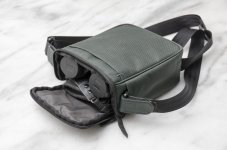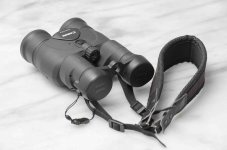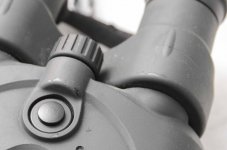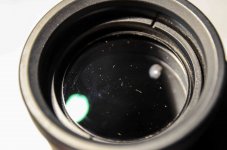CANON IS III 12X36 - ONE YEAR REVIEW
In a few days it will be one year since I bought the Canon IS 12x36. Since then, they have been my most used binoculars, I’ve probably used them every 3 out of 4 times I grabbed an optic. I reckon I’ve used the Canon more than half of the days of the year, so say between 180 and 200 days. It’s hard to estimate the number of hours, because some days it has been used for a brief 30 minutes check on something, while others I’ve used it for 3 - 4 hour birding sessions. All in all, several hundred hours using it, so I can now say I have a pretty accurate feel of what is it like to live with it, and these are my findings, hope it can be useful for other forum members. The good, the not so good and the right down awful.
Re-accesorizing
Let’s begin with the first impression, say accessories. I wrote about it earlier in this thread, but a short reminder that both case, neck strap and objective covers (well, lack thereof) are appalling, probably among the worst I’ve seen, especially considering it’s a +700 € device. I really think Canon must reconsider its strategy here. Many 300 binoculars € come with lovely neck straps and cases that fulfill their purpose, offering protection and ease of transportation. Anyway, I’ve provided the Canon with much needed improvement in those areas, as can be seen in the following picture).

I use the case of the Swarovski EL 8x32 (the same one used in the SLC 8x42) that is ridiculously large for a 8x32 model). It fits the Canon really well, a snug fit but not too tight, and the lid offers enough room to accommodate the strap, given that the case has a very long “safety belt style” strap that makes wearing it bandolier style a real pleasure.
For the rain guard, I use on from a Zeiss Conquest HD with the little loop-connector system from the objective covers of the same Contest HD, which is my favourite way of carrying the rain guard. It’s super fast and convenient to flip it open and, when you don’t want the rain guard at all (say you are in an observatory, or simply feel you don’t need it) can be easily clipped off and kept in a pocket, without the hassle of de-looping/re-looping it.
Finally, the neck strap of a 10x50 Vortex Viper HD is way wider (and cushioned!) than the ridiculous strap provided by Canon, so that it’s way more comfortable to carry it for long hours. Loaded with batteries, my unit weights 695 g.
 Battery life
Battery life
The specs say the batteries last 9 hours. But what does that mean on the field? If I watch a warbler pass by and press the button… is that 5 seconds? Does it add up linearly? Or is it like a car that consumes more the moment you start it and then the rate is at a steadier pace? Even after reading everything I could find about the IS III I just couldn’t imagine how it would perform in the field. I remember reading few testimonies about an average battery life, which for me was a crucial aspect. I guess like many other binocular lovers, what I love about conventional binoculars is that they’re mechanical devices, and I admire the pure beauty of the engineering and design solutions put in place in different models. I love that they don’t need batteries to operate, and thus are not tightly bound to obsolescence and fail as electronic gadgets and appliances. So, spending a reasonably big amount of money on an electronic gadget was a pretty big pill to swallow. In my case, these are my battery life figures over a year of use. I’ve used them mostly in the mild Mediterranean weather. I took them to the Pyrenees for Christmas, but even there I don’t think they ever were below 0º C.
Battery change dates (Energizer batteries)
- 10.06.21
- 19.08.21
- 3.01.21
- 9.04.21
So, between 2 and 3 months, and I’m still using the 4th pair, which I reckon will last until somewhere in late June or early July. So, 4 battery changes in one year. The funny bit is that I bought a set of Eneloop rechargeable batteries, but while they arrived, I bought a set (8) of regular disposable batteries, by fear of running out of juice before the Eneloop arrived (I simply didn’t know what to expect in terms of range). It turns out my fear was unfounded. Truth be told, I’ll be using my first set of Eneloops after the current Energizer dies, so at the moment I don’t know if there’s a difference between them and the disposable ones. I have a set of the white Eneloop and in my Speedlite flash I have a set of the black ones that I’ve been using over the last 7 years and that have worked great (and continue to do so).
All in all, I’ve been really surprised with the life of the batteries. I don’t know if other users may get more or less use out of a pair of batteries, maybe different temperatures and birding styles create big differences (what’s your change rate?). I don’t do a lot of observatories, I’m usually on the move. Maybe if you’re watching migratory birds for hours, or sitting in an observatory watching waders for a long time, the batteries will last less. I’m really pleased. As a matter of fact, I never use the Canon without the IS; the moment I grab them, I press the IS button. In fact, I’m not 100 % sure that I’ve actually exhausted the life of the batteries I’ve used. The Canon have never stopped working. I’m under the impression that they started working less well, less efficiently, so I changed the batteries, but I’m not 100 % (they could do with an orange LED indicating the need for a change).
Stabilization IS
Regarding the stabilization itself, I must say that I’ve also been pleasantly surprised. Maybe it’s because the stabilization in the 12x36 IS III was the last iteration of that model, but I’ve found it to be really fast, no lag whatsoever and amazingly stable, sometimes you got the feeling of being on a tripod. It’s that good. This simply allows to see more. I’d say (and this could be the summary) that the Canon IS III accomplish the ultimate goal of binoculars: they bring closer distant objects so that you can see them in detail. And they do this in a way that simply puts to shame any “alpha” from the big brands. I’ve lost count of the opportunities when out birding with brother/friends/relatives there was this moment of someone saying “What is that sitting on that ledge on the cliff… I just can’t…”, and I went: “It’s species X. Oh, and, by the way, it has a prey on its claws”. This has to be experienced. For me, this is what justifies the many (MANY) drawbacks of this model (more on that later): you simply see more, more detail, closer… but not “better”. When in use, the image quality is nowhere near the 700 € price tag would suggest.
A couple of notes.
- Singlehand.When I’m birding, sometimes I carry my scope or other thing, so that sometimes I have to “singlehand” the binoculars. Some models are better at this, especially compact 8x32, I can hardly singlehand a 10x with enough quality… and here comes a 12x that you can singlehand and get an incredibly detailed image.
- Astro. IS is an absolute game changer for astro. Yes, you’ve probably read it before, I found it to be true. Well, I’d say it’s a game changer for appreciating detail, be it splitting a double star or making out details on plummage that help you identify a bird.
- Pictures. I very often take pictures through my scope an binoculars, they serve as reference, to remember something, to show to friends, to justify a “rare” sighting, or to check a detail back home. IS makes this so easy and is able to provide amazing detail for such a rudimentary technique.
So, how’s the view?
Well, there are two aspects to this. When you first test the Canon with IS turned off, like watching a tree, bush or object, the image is pretty good, I’d say as good as many 400 - 500 € binoculars: sharp, good contrast, field of view is OK (I’ve read negative reviews of this aspect, but 5º for a 12x seems reasonable to me, after all, there are many 10x50 with 5º). However, the second part is not that nice: if you start using the Canon on more challenging situations (basically, birding), objects on the move, against the sky, on a branch, and activate IS you discover a serious amount of colour fringing. I remember well the first swallow I saw with the Canon. I mean, I knew it was a swallow, but had I not known that bird species, I might as well have thought it was a colourful bee-eater, given the incredible amount of colour fringing of a dark silhouetted bird against a bright Summer sky. However, it has to be said that colour fringing is specially strong on back-light/high-contrast situations, and specially when you are panning or following something swiftly. The moment you “locate”/acquire the bird, even if you are panning, the level of CA diminishes, it’s hard to explain.
While using the Canon 8x20 IS Canip might have experienced something similar, this is what he wrote:
The 8x20 shows clearly less CA than the Canon 10x32 (in the latter, the higher magnification of course may contribute a bit o). I noticed that while the IS is switched on, a little more CA becomes visible during panning than when the device is without moving. The increased CA disappears as soon as the panning movement stops. Incidentally, this finding also seems to appliey to the 10x32 (and possibly also to other Canons ?? Or stabilized binos in general ?? Or just an impression in my eyes?? To be explored further).
Then, when IS is ON I don’t think the sharpness and contrast compare favourably to contemporary roofs costing 700 € (let alone to a similarly priced Porro like the Habicht). The image is soft and many times lacks the sparkle and punch you can experience for that sort of money. It’s a weird finding: you can see more detail with a worse quality. Up until using IS, my impression was the opposite, my experience told me that the better the image quality (in terms of sharpness, bright, costrast) the more detail you could see. Strange, revealing.
Focusing is OK. I find the focus wheel on the small side, compared to most x42 binoculars (the natural rivals of this very peculiar 12x36). Action is good, soft, but when changing direction is not as good as similarly priced roofs (or classic porros, like the Nikon EII or SE, for example, with their flawless mechanical action). It somehow reminds me of the Pentax Papilio. While focus is OK, it gets the job done. Bear in mind that, being a 12x with the shallow depth of field of 12x, there is quite a lot of “job” to be done. So maybe that’s the reason you use the focus more than in any other binoculars, and the reason why in this particular device it’s under quite a lot of demand. And then there’s the minimal close focus distance. I know there’s a lot of debate about this. While I do enjoy some of the binoculars that I have (or had) with a short close focusing distance, say 1,8 m (6 feet), it’s not something I would deem essential, and I’m perfectly happy with about 3,5 m (11 - 12 feet), but this have a whooping 6 m. I was a bit intimidated by it, and it is true that I’ve lost several sightings because of that. How many? It’s hard to say… maybe 5 to 10 in one year. While you could argue it’s not terrible, one or two were migrants that could have been a rare sighting. So not happy about it. I would not recommend them for intensive close range use, obviously.
What about low light conditions? Well, in those conditions my 8x32 appears brighter but, again, that’s the “how”, the “what” (can I see more?) is still on the Canon side. As a matter of fact, in poor light conditions you have to get used to the image not being as bright as you’re used to. There’s a lot of useful detail, but it’s more tiresome than another brighter pair with a larger exit pupil or larger objectives. In fact, I’d say this is a constant when using the 12x36 (probably has to do with the fact that they’re 12x as well as being IS). It gives you a lot, but you have to “work harder”, the view is not so peaceful and effortless. Coming from the 12x36 Canon to an 8x32 or something like a 7x35 is like going to a SPA for a massage and a warm bath, so relaxing.
Usability
Fail. Move on.
I could very well end up this section like that, but let me elaborate. When you first put the IS III to your eyes you feel you are holding a brick, then you naturally try to find the right IPD, and this is something the Canon are not brilliant at (to say the least). They lack the traditional bridge, so you have to move the eyepieces. OK, doesn’t seem much of an issue, but it turns out the eyepieces don’t move smoothly as your typical bridge, they’re hard to move and have very little play to fine tune your IPD. The result is that whenever I pass them on to my partner so she can enjoy a quick glance of something special, I spend way more time that I’d like readjusting the IPD back. It’s a bit of a pain.
OK, so you’ve finally adjusted the IPD, now you encounter those soft rubber eyecups… Argh! I’ve used many classic Porros, and the Canon are not among the most comfortable. And then there’s the issue with the dioptre adjustment. It’s not as if you had to adjust it every single day you go birding… it actually moves at the slightest touch (like rubbing agains your chest), so I’ve found I need to re-adjust it several times even in the same session. I’ve never seen anything like that. Obviously many times they move when you take the binos out of the case and so on. A stupid design fail: they turn to easily.
And then there’s a simple and terrible fact: you have to push a button (all the time) to make it work. Imagine you buy a nice 700 - 800 € Opticron, Leupold, Meopta, etc… only to find that it does not provide its full potential unless your finger is constantly pressing a button. I find the mere idea of putting this into production ludicrous. But there you go, I guess you learn to live with it. Even after one year of use I’m still amazed of how an engineer (or a budget controller) at Canon thought this was acceptable.
So, the ergonomics are terrible, it’s like holding a Fax machine from the 90s in your hands, the eyecups are quite horrible, the dioptre adjustment moves inadvertently, the focus wheel is too smal, adjusting the IPD is far from ideal (or far from what any 100 € device can do) and you have to constantly press a button to make it work.
Finally, there’s the lack of waterproofness. And yes, there have been several times (I’d say maybe 4 or 5) where I wanted to bring the IS but the sensible thing was to leave it at home and bring something more rugged. It’s a real pity when you want to use it but you know you shouldn’t. I have indeed used it under a slight drizzle, and it coped well. I dried it with a cloth and let it to dry on a rack (like you do with baked goods) in good ventilation.
Condition after one year of use
As I said earlier, I’ve used the Canon probably more than half of the days of the year, and to my surprise it can be noticed more than I’d expected (or more than I have experienced with other armoured binoculars). No I haven’t had any issue in the entire year, no electronic or optical fail, good reliability here. Maybe less important, but worth noting is the cosmetic part. The outer layer of plastic (the soft one that “melts” in many units) has started to disappear in areas where the binoculars rub against the case (I suppose) or my clothes.

More worrying, but to be expected at some point due to the lack of weatherproofing, is the fact that there already is a noticeable amount of dust inside the objective tubes. Nothing terrible, but visible nonetheless. I’ve read many testimonies of Canon IS binoculars lasting in excess of 10 years. I wonder how my unit will last if it accumulates 10 times the amount of debris it has right now.
 Conclusion
Conclusion
This is one of those times in life when you are confronted with a serious set of drawbacks to overcome one big advantage.
If you list all the things I don’t like and then the things I like it goes like this:
CONS:
Price
Ergonomics
Usability
Image quality (soft)
Chromatic Aberration
Dioptre adjustment moves
Need for batteries
Close focus is pretty bad
Lack of waterproofness
Lack of shockproofness
Depreciation of an electronic gadget
Durability
PROS:
You see more
One of the ideas I gathered while first using the Canon IS III 12x36 (I think I wrote about it some months ago) is that WHAT they do is amazing: they show you more, simple as that. You can see more than with a 2500 € non-IS state-of-the-art alpha. In fact, they show you more than anything but a binocular on a tripod could do. This is just mind-blowing and a true revelation. But then, the HOW they do it has many, many, many bends (read the list of cons again). After one year, I’ve been amazed by what the Canon have given me, but also frustrated by some of the shortcomings mentioned. I remember the strong wish of selling it after the first week of use, and how that wish went slowly fading off the more I used it. After one year, and several hundred hours in the field, I think of the Canon IS as an old friend whose craze, shortcomings and shades you know well, but you have learnt to live with. Whenever I go from the Canon to my 8x32 EL SV is like if someone had just switched the 4K button on. The image is sparkling and vivid, but there’s something missing. Even when using 7x (which is something I love) I can feel a very subtle jitter that can become irritating.
As an everyday pair, the Canon are very nice, probably a little too bulky, although not terribly heavy (at 695 g with batteries), maybe the close focus and lack of waterproofing are the worst. The cons are a lot, but IS can give you so much more, that in my case I think it’s worth it. So much so, that I’ve decided to try the 8x20 IS that has gathered good reviews (I remember Canip’s positive comments), that model overcomes two of the shortcomings: size and close focus, while there is a new one: small exit pupil and tiny objectives (well, it seems you can’t have it all). In fact, I’m thinking that a compromise could be the new10x32 IS. A 3,2 exit pupil, a good 6º FOV (nearly as good as the 8x20), but again, it has grown a lot fatter (+800 g with batteries).
(Sorry for the lenghty post, a little longer than I anticipated.)











